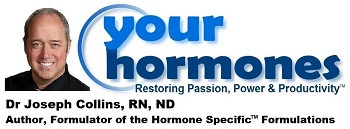
Actions of Testosterone by Joseph J. Collins, RN, ND
In women, testosterone is a steroid hormone produced primarily by the ovaries and adrenal glands. Testosterone has a direct affect on blood sugar levels and the function of the reproductive system, the nervous system, the cardiovascular system, the skeletal system and other tissues. Like all steroid hormones, excessive amounts of testosterone can contribute to a number of increased health risks.
Though testosterone is commonly associated with libido, proper testosterone levels are critical for the prevention of depression and osteoporosis. Following is a list of some of the actions and functions of testosterone. More information and more references can be found in the book Discover Your Menopause Type?
The Menstrual Cycle and the Endometrium
Excessive testosterone levels may increase risk of endometrial cancer due to hyperinsulinemia 1, 2.
The Vagina & Urinary Tract
Testosterone may decrease vaginal atrophy as well as inflammation, itching and pain of the vulva 3, 4
The Libido
Testosterone Is the most important hormone for maintaining sex drive in women 5, a deficiency can cause impaired sexual function 6. Normal testosterone levels can result in increases sexual satisfaction, increases responsive to sexual activity, increases sexual activity 7, 8.
Blood Sugar & Insulin
Excessive testosterone levels can result in insulin resistance 9 with increased glucose and insulin levels 10.
Increased testosterone levels may also contribute to increased obesity (since high insulin levels increase fat storage) 11 and increased risk of heart disease and diabetes 12, 13
The Brain – Mood & Memory
Depression is one of the major symptoms associated with low testosterone levels in women 14. Low testosterone has a significant negative effect on mood, personal sense of well being, interpersonal relationships, self-confidence and self worth 15, 16.
The Breasts
Though high testosterone levels may occur with 17 or even before the breast cancer 18, the increased insulin levels caused by excessive testosterone may be the direct cause 19, 20. (Note: Estrogen replacement therapy can restore balance and control high insulin caused by too much testosterone 20.)
The Skin
Testosterone can preserve skin collagen and protect the skin from thinning 21, 22, as well as sebaceous glands activity which lubricates the skin 23.
Bones & Osteoporosis
Testosterone (and its metabolite dihydrotestosterone) directly stimulate receptors on the osteoblast (bone building) cells to stimulate bone growth, bone mineralization and repair of damaged bone 24, 25, 26, 27, 28, 29, 30. Testosterone replacement can effectively decrease osteoporosis in and of itself 31, 21, 32, 33.
Androgens such as testosterone appear to work together with estrogens to preserve and rebuild the joint cartilage between bones 35.
The Heart
Testosterone has a relaxing (vasodilating) effect on coronary arteries 36, 37, 38, and can decrease symptoms of angina. Women are not given required testosterone may be at a much greater risk of coronary artery heart disease 39.
Though testosterone given alone can promote atherosclerosis and decrease HDL (good cholesterol) 40, it does not have the same effect if given with estrogens 36. The increased risk of heart disease associated with excessive testosterone is associated with insulin resistance 12, and can be improved by giving estrogen to balance the excess 41.
References:
(1) Ciampelli M, Lanzone A. Insulin and polycystic ovary syndrome: a new look at an old subject. Gynecol Endocrinol 1998 Aug;12(4):277-92
(2) Gamayunova VB, Bobrov YuF, Tsyrlina EV, Evtushenko TP, Berstein LM. Comparative study of blood insulin levels in breast and endometrial cancer patients. Neoplasma 1997;44(2):123-6
(3) Leiblum S, Bachmann G, Kemmann E, Colburn D, Swartzman L. Vaginal atrophy in the postmenopausal woman. The importance of sexual activity and hormones. JAMA 1983 Apr 22-29;249(16):2195-8
(4) Friedrich EG Jr, Kalra PS. Serum levels of sex hormones in vulvar lichen sclerosus, and the effect of topical testosterone. N Engl J Med 1984 Feb 23;310(8):488-91
(5) Sherwin BB. Sex hormones and psychological functioning in postmenopausal women. Exp Gerontol 1994 May;29(3-4):423-430
(6) Sands R, Studd J. Exogenous androgens in postmenopausal women.
Am J Med 1995 Jan 16;98(1A):76S-79S
(7) Persky H, Lief HI, Strauss D, Miller WR, O'Brien CP. Plasma testosterone level and sexual behavior of couples. Arch Sex Behav 1978 May;7(3):157-173
(8) Davis SR, Burger HG. Use of androgens in postmenopausal women. Curr Opin Obstet Gynecol 1997 Jun;9(3):177-180
(9) Falkner B, Hulman S, Kushner H. Gender differences in insulin-stimulated glucose utilization among African-Americans. Am J Hypertens 1994 Nov;7(11):948-52
(10) Haffner SM, Valdez RA. Endogenous sex hormones: impact on lipids, lipoproteins, and insulin. Am J Med 1995 Jan 16;98(1A):40S-47S
(11) De Pergola G, Triggiani V, Giorgino F, Cospite MR, Garruti G, Cignarelli M, Guastamacchia E, Giorgino R. The free testosterone to dehydroepiandrosterone sulphate molar ratio as a marker of visceral fat accumulation in premenopausal obese women. Int J Obes Relat Metab Disord 1994 Oct;18(10):659-64
(12) Khaw KT, Barrett-Connor E. Fasting plasma glucose levels and endogenous androgens in non-diabetic postmenopausal women. Clin Sci (Colch) 1991 Mar;80(3):199-203
(13) Andersson B, Mattsson LA, Hahn L, Marin P, Lapidus L, Holm G, Bengtsson BA, Bjorntorp P. Estrogen replacement therapy decreases hyperandrogenicity and improves glucose homeostasis and plasma lipids in postmenopausal women with noninsulin-dependent diabetes mellitus. J Clin Endocrinol Metab 1997 Feb;82(2):638-43
(14) Sands R, Studd J. Exogenous androgens in postmenopausal women. Am J Med 1995 Jan 16;98(1A):76S-79S
(15) Khastgir G, Studd J. Hysterectomy, ovarian failure, and depression. Menopause 1998 Summer;5(2):113-22
(16) Persky H, Lief HI, Strauss D, Miller WR, O'Brien CP. Plasma testosterone level and sexual behavior of couples. Arch Sex Behav 1978 May;7(3):157-173
(17) Kaaks R. Nutrition, hormones, and breast cancer: is insulin the missing link? Cancer Causes Control 1996 Nov;7(6):605-25
(18) Berrino F, Muti P, Micheli A, Bolelli G, Krogh V, Sciajno R, Pisani P, Panico S, Secreto G. Serum sex hormone levels after menopause and subsequent breast cancer. J Natl Cancer Inst 1996 Mar 6;88(5):291-6
(19) Bruning PF, Bonfrer JM, van Noord PA, Hart AA, de Jong-Bakker M, Nooijen WJ. Insulin resistance and breast-cancer risk. Int J Cancer 1992 Oct 21;52(4):511-6
(20) Andersson B, Mattsson LA, Hahn L, Marin P, Lapidus L, Holm G, Bengtsson BA, Bjorntorp P. Estrogen replacement therapy decreases hyperandrogenicity and improves glucose homeostasis and plasma lipids in postmenopausal women with noninsulin-dependent diabetes mellitus. J
(21) Brincat M, Moniz CF, Studd JW, Darby AJ, Magos A, Cooper D. Sex hormones and skin collagen content in postmenopausal women. Br Med J (Clin Res Ed) 1983 Nov 5;287(6402):1337-8
(22) Brincat M, Moniz CF, Kabalan S, Versi E, O'Dowd T, Magos AL, Montgomery J, Studd JW. Decline in skin collagen content and metacarpal index after the menopause and its prevention with sex hormone replacement. Br J Obstet Gynaecol 1987 Feb;94(2):126-9
(23) Pochi PE, Strauss JS, Downing DT. Age-related changes in sebaceous gland activity. J Invest Dermatol 1979 Jul;73(1):108-11
(24) Saito H, Yanaihara T. Steroid formation in osteoblast-like cells. J Int Med Res 1998 Jan;26(1):1-12
(25) Nishimura S. [Role of testosterone propionate and insulin in the regeneration and growth of bone].[Article in Japanese] Meikai Daigaku Shigaku Zasshi 1990;19(3):291-309
(26) Kasperk CH, Wergedal JE, Farley JR, Linkhart TA, Turner RT, Baylink DJ. Androgens directly stimulate proliferation of bone cells in vitro. Endocrinology 1989 Mar;124(3):1576-1578
(27) Gasperino J. Androgenic regulation of bone mass in women. A review. Clin Orthop 1995 Feb;311:278-286
(28) Nakano Y, Morimoto I, Ishida O, Fujihira T, Mizokami A, Tanimoto A, Yanagihara N, Izumi F, Eto S. The receptor, metabolism and effects of androgen in osteoblastic MC3T3-E1 cells. Bone Miner 1994 Sep;26(3):245-259
(29) Bruch HR, Wolf L, Budde R, Romalo G, Schweikert HU. Androstenedione metabolism in cultured human osteoblast-like cells. J Clin Endocrinol Metab 1992 Jul;75(1):101-105
(30) Takeuchi M, Kakushi H, Tohkin M. Androgens directly stimulate mineralization and increase androgen receptors in human osteoblast-like osteosarcoma cells. Biochem Biophys Res Commun 1994 Oct 28;204(2):905-911
(31) Wakley GK, Schutte HD Jr, Hannon KS, Turner RT. Androgen treatment prevents loss of cancellous bone in the orchidectomized rat. J Bone Miner Res 1991 Apr;6(4):325-330
(32) Davis SR, Burger HG. Use of androgens in postmenopausal women. Curr Opin Obstet Gynecol 1997 Jun;9(3):177-180
(33) Tremollieres F, Pouilles JM, Ribot C. [Postmenopausal bone loss. Role of progesterone and androgens].[Article in French] Presse Med 1992 Jun 6;21(21):989-993
(34) Nishimura S. [Role of testosterone propionate and insulin in the regeneration and growth of bone].[Article in Japanese] Meikai Daigaku Shigaku Zasshi 1990;19(3):291-309
(35) Somjen D, Weisman Y, Mor Z, Harell A, Kaye AM. Regulation of proliferation of rat cartilage and bone by sex steroid hormones. J Steroid Biochem Mol Biol 1991;40(4-6):717-723
(36) Sarrel PM. Cardiovascular aspects of androgens in women. Semin Reprod Endocrinol 1998;16(2):121-8
(37) Yue P, Chatterjee K, Beale C, Poole-Wilson PA, Collins P. Testosterone relaxes rabbit coronary arteries and aorta. Circulation 1995 Feb 15;91(4):1154-60
(38) White CM, Ferraro-Borgida MJ, Moyna NM, McGill CC, Ahlberg AW, Thompson PD, Chow MS, Heller GV. The pharmacokinetics of intravenous testosterone in elderly men with coronary artery disease. J Clin Pharmacol 1998 Sep;38(9):792-7
(39) Rako S. Testosterone deficiency: a key factor in the increased cardiovascular risk to women following hysterectomy or with natural aging? J Womens Health 1998 Sep;7(7):825-9
(40) Crook D, Seed M. Endocrine control of plasma lipoprotein metabolism: effects of gonadal steroids. Baillieres Clin Endocrinol Metab 1990 Dec;4(4):851-75
(41) Andersson B, Mattsson LA, Hahn L, Marin P, Lapidus L, Holm G, Bengtsson BA, Bjorntorp P. Estrogen replacement therapy decreases hyperandrogenicity and improves glucose homeostasis and plasma lipids in postmenopausal women with noninsulin-dependent diabetes mellitus. J Clin Endocrinol Metab 1997 Feb;82(2):
